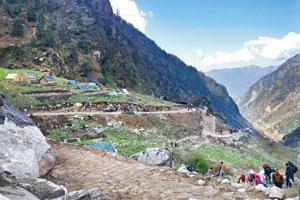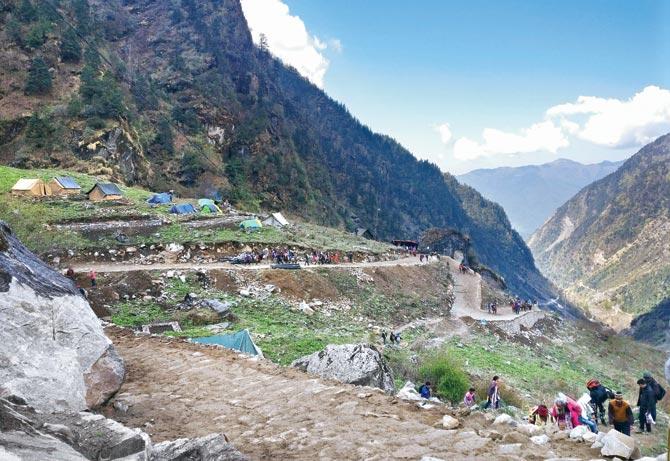As the season for the mountain pilgrimage begins, here's what to expect from the journey


A result of the 2013 floods, which wreaked havoc and killed thousands of people, is that the river Mandakini, which passes the temple area disappears after a stretch
ADVERTISEMENT
I happily strut on through the Gaurikund market where vendors pour hot chai and roll parathas for eager yatris freezing under their overalls. It is April 29, the first darshan of the season. I have set out at 4.45 am, dodging horses and men wearing pithoo baskets ready to carry pilgrims to the top. I am in the company of a rishi, who grins at my woollens. "It is going to be sunny today," she says, wrapping a rice-paper thin shawl over her white skirt and blouse.

The path is peppered with signboards advising yatris to check their pace
Trek record
A cobbled path begins where the kaccha road ends. A green signboard reads: Kedarnath 16 km. The 2013 flood washed away the old route. Uttarkashi's Nehru Institute of Mountaineering re-charted the route via Gaurikund and passing Jungle Chatti Bheembali and Linchauli to reach the basecamp. Then, another kilometre leads to the temple. Rain shelters, medical camps, bio toilets and potable water fountains appear frequently.

The path has toilets and food stalls and medical camps are regular intervals
When the going gets tough
Uphill, at gradient 8, I set a steady pace, holding onto an orange railing; matching the sparse spotting of crimson-red Buransh flowers in an otherwise green flora valley. The gushing of a waterfall and a dawn in the breaking lend a quietude broken by enthusiastic cries of "Jai Bhole!" and "Har Har Mahadev!". I stop at each signboard that advises walkers to take regular breaks. An hour of evening walk in the city, I realised, was not enough training to adjust to the thin air quality and keep the body supple.

The flood had washed away the old route
Giving up is easy
Ahead of me, a couple plonks onto a bench. "Aur kitna dur hai," the wife asks. A sweeper, cleaning the tracks, laughs, "Bas che ghante chalte jao. Upar mat dekho (Keep walking continuously for six hours. Don't look up to see how far it is)." By now, I have lost sight of my 58-year-old companion, who has kept a steady lead.
I stare at the green board that reads 14 km, the time is 5.30 am. A tendency to get cramps on my right leg, I am surprised it hasn't revolted yet. But there's a sharp pull in my thigh, a new pain on this new adventure. I think to myself: "Why did I sign up for this? Turn back. Just turn back." Probably from the distress look on my face, a woman on horseback sees me and screams from afar: "Don't give up. You will make it."
The tough get going
This is my first victory. To turn a deaf ear to my feet's pleads. By the time I make it to Bheembali, the road steepens. People who have finished their darshan shower encouraging words and promise the ever-winding road will smoothen. By the time I reach Kedarnath basecamp, the clouds have covered the peaks, and there's a light rain splatter. I follow a group through steep patches that help you cut the road time. Sometimes, I find myself on all fours, holding onto branches. My inspiration pool is slowly evaporating.
Miracles find you
In that moment, the clouds clear and the snow peaks make an appearance. It fills me with gratitude — for everything that is right and wrong in my life. The walk down to the confluence of the Mandakini and Saraswati and dip my hands in the icy cold water. I skip the line to the temple, bow to the dhwaj on the temple and turn around for the road downhill.
A walk to remember
The rains have washed the muddy road and turned it into a sludge fest. I follow a couple and their son down a 'short cut' which catches me off-guard. It is open to the valley, and one wrong step will have me tumbling down. This descent is long but we walk it with a joyous gait. The burden was my own uphill, but now, it is ours to share.
8
No. of hours it takes in a state-run bus from Rishikesh to Sonprayag
Adventure & Religious
Tour & taste
Food and Leisure
Relaxing
Educational

 Subscribe today by clicking the link and stay updated with the latest news!" Click here!
Subscribe today by clicking the link and stay updated with the latest news!" Click here!






